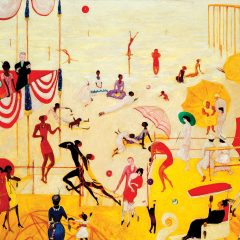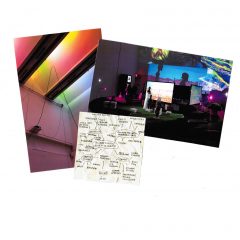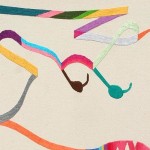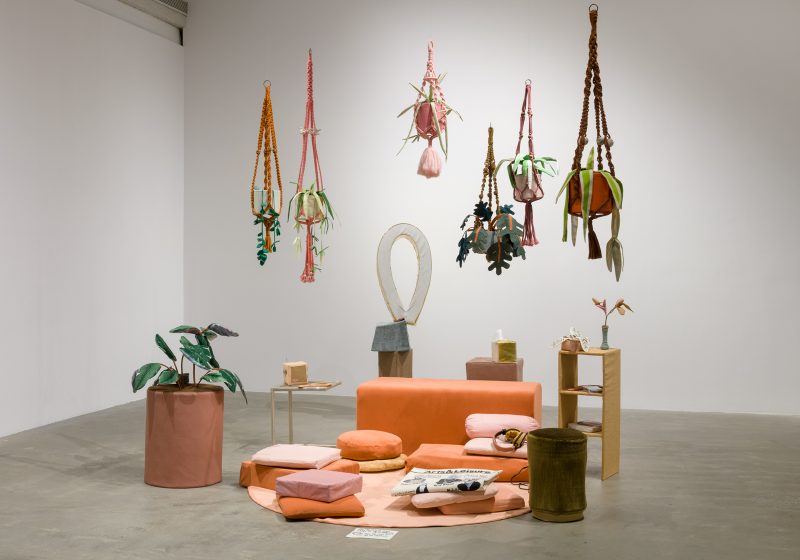
Loitering is delightful, the most recent show at Los Angeles’ Municipal Art Gallery in Barnsdall Art Park, did not entirely fulfill its subversive and radical aims. Keeping in mind the increasing privatization of public space in the United States, and the growing lack of “third spaces” where people can simply exist, enjoy themselves, and not have to buy something to be permitted entry (like a public library or park), Loitering is delightful hoped to delve deep into what it means to linger in a space, unhurried or moved along by the outside world, perhaps to the extent that it becomes taboo. As an arts space with free admission that is operated not as a commercial gallery, but by the city of Los Angeles, the Los Angeles Municipal Art Gallery was in a strong position to unpack the differences between lingering in a space and loitering in a space, acknowledging right off the bat that the idea of loitering is deeply politicized and racialized in the United States. And within an art world that is overwhelmingly white and wealthy, where visitors of color often feel targeted for not fitting the profile of someone who seems to naturally belong in a museum, it’s clear that the Los Angeles Municipal Art Gallery, with shows like Loitering is delightful, was throwing its hat into the ring to be that “third space” for all Angelenos.
Loitering is delightful asked in its opening text: “at which point does lingering cross into criminal territory? What does ‘loitering’ really mean? And why is it frowned upon?” The artists in this show–Milano Chow, Lauren Davis Fisher, Ishi Glinsky, David Horvitz, Dylan Mira, Joshua Ross, Asha Schechter, Cauleen Smith, Lani Trock, and Megan Whitmarsh–were invited to participate based on this theme, and many of them created brand new work for the exhibition.
Unfortunately, not all of these artists delved as deeply into the theme of loitering and grappled with its murky societal connotations. Instead, some of the artists in this exhibition chose to interpret “loiter” as “linger” or even “relax,” focusing on creating an aesthetic of lingering or relaxing that would not be out of place in a magazine spread or design vision board. Lani Trock’s “the unified field,” for example, was a striking installation involving cushions, fabric, and flowers laid out in a serene, meditative way. The work was quite lovely, encouraging a moment of pause and reflection, yet even in the text accompanying the work, “the unified field” was described as “an invitation to linger,” meaning that this work, to my mind, did not adequately address that there is a difference between lingering and loitering. If you are invited to linger, you are not, by definition, loitering.
Similarly, David Horvitz’s invitation to stop for a moment and enjoy tea made with water that was once mountain snow did not engage with what it means to loiter, while Megan Whitmarsh’s “Arts and Leisure Section” delivered a dusty rose-hued reading nook replete with fabric plants, furniture, and newspaper that, once again, invited us to sit and relax and take it all in. (Ironically, “Arts and Leisure Section” felt so perfectly decked-out and homey that if you sat in it, you could imagine that it was your space and that it was the other gallery visitors who are trespassing, or loitering in your living room.) The fact that we were encouraged to view the works in Loitering is delightful almost as time-based—that we were invited to enjoy them for as long as we like (gallery hours permitting)—undermined the taboo undercurrents of what it means to loiter: to remain in a place where you aren’t wanted.
Happily, there were several works in Loitering in delightful that demonstrated, whether explicitly or implicitly, that who is invited and who is loitering is deeply politicized. Joshua Ross’ series of photographs, Zhani, depicted his partner Devion Law on a dimly-lit city street in the midst of elaborate, graceful motions—motions that do not fall within the norm of walking or standing or sitting, but that draw attention to themselves and to their performer. To this day, African Americans are arrested on “loitering” charges merely for being somewhere someone deems they shouldn’t be; with that inequity in mind, it’s impossible not to see the sheer danger implied in these photographs—the risk that Law, who is Black, courts by the nature of his existing in public and not acting in an expected way.
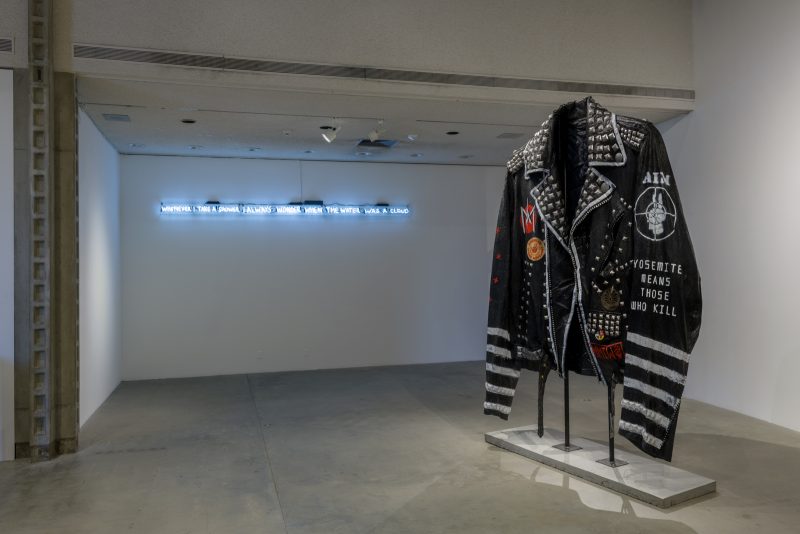
“Coral vs. King Snake “Jacket,” 2019. Canvas, ink, embroidered patches.
Glinsky’s “Coral vs. King Snake ‘Jacket,’” evoked racialized conflict over who is allowed to occupy space and who is considered unwelcome while riffing on a popular vocabulary of loitering. Reminiscent of the textiles of Ursula von Rydingsvaard, “Coral vs. King Snake ‘Jacket’” took the form of a massive leather jacket, with painted canvas used to simulate leather’s sheen. The immediate cultural reference was obvious: everyone knows the icon of the bad boy in a leather jacket who’s hanging around where he shouldn’t be, whether he’s a greaser or a punk. Glinsky incorporated the metallic studs found on the outfits of punk fashion into his jacket, nodding to punk explicitly as a subculture that occupies space in defiance of propriety; he also referenced the 1960s-1970s activism of the American Indian Movement in embroidered designs on the jacket. The synthesis of Native American tribal imagery and symbols within the context of loitering, and occupying space, and asserting ownership over space, was a firm reminder that the Los Angeles Municipal Art Gallery, and pretty much all of “America” as it’s been built and cultivated, loiters unrepentantly on stolen Indigenous lands.
In contrast to his more elaborate tea-drinking project, David Horvitz’s neon letter sculpture hinted at the possibility of mental loitering, rather than physical. The text, placed high on the wall, read “Whenever I take a shower, I always wonder when the water was a cloud.” More than the tea drinking or the printmaking elements to his work in this exhibition, this work aligned itself with the theme of being somewhere you shouldn’t be for just a little too long. This mental loitering conjured up the kinds of thoughts that drift across your consciousness when you’re in the shower. It’s the kind of mood of being finished with washing up, when you’re just standing under the hot stream of water. You’re unwilling to leave this warm place that exists outside of time, but you’re waiting for the inevitable sign that you have to turn off the water and rejoin the world and its obligations.
Horvitz’s “Proposal for Clocks,” a series of posters imagining different ways to tell time, had a similar effect of encouraging mental disobedience towards the norm of strictly useful and accounted-for time. Likewise, a pairing of video works by Cauleen Smith, “BLUE SCRUBS, YELLOW SCRUBS, TRUSTEES ALL ABOVE” and “ORANGE JUMPSUIT,” referenced the reality of disproportionate carceral consequences for people of color while also hinting at a previously unexplored form of loitering. In the videos, Smith carefully arranged flowers the color of various prison uniforms; according to the accompanying text, Smith then left these arrangements outside the Los Angeles County Jail as a “memorial”–but also as a silent occupation, a loitering of flowers that only ceases when they dry up and die.
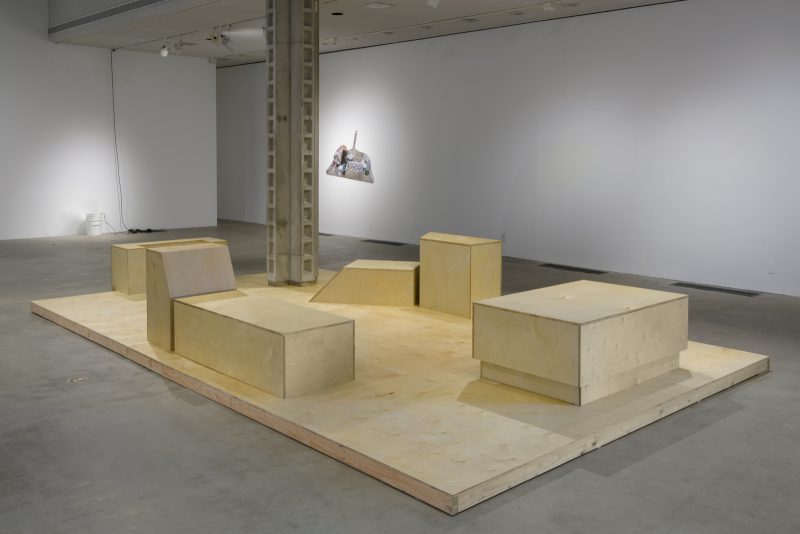
Meanwhile, Lauren Davis Fisher’s simple plywood “Municipal Boxes” allowed the Los Angeles Municipal Art Gallery to gently criticize itself as a place that might not be comfortable for everyone—that some visitors might feel as though they could be loitering in a place they aren’t wanted, which is pursuant to its implicit desire to be a “third space”. According to the gallery’s text, the artist created these plywood forms for people to sit on in the gallery because of the space’s “imposing concrete architecture” that “served to discourage people from lingering within.” “Municipal Boxes” cannily demonstrated that sometimes aesthetics and design are all it takes for someone’s lingering to feel like someone else’s loitering, and vice versa. With the addition of a few plants and cushions, “Municipal Boxes” could have been a trendy hangout spot in gentrifying Culver City only a few miles away, where the line between who is and isn’t the target audience is that much more defined.
“Loitering is delightful” (NOW CLOSED) October 31, 2019 – January 12, 2020, Los Angeles Municipal Art Gallery, 4800 Hollywood Boulevard, Los Angeles, CA 90027



